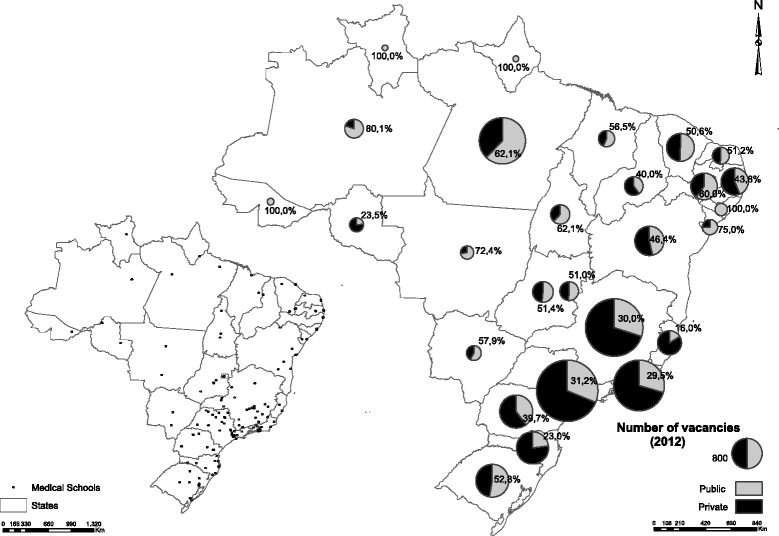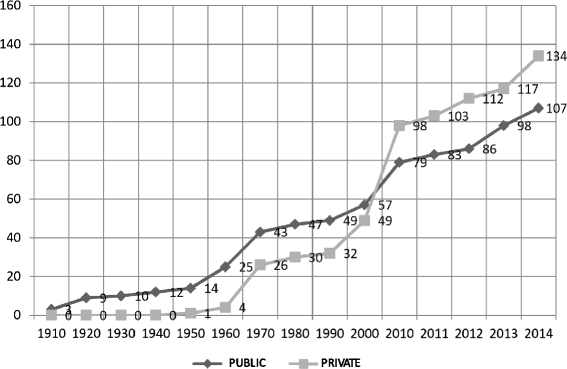The privatization of medical education in Brazil: trends and challenges
- PMID: 26678415
- PMCID: PMC4683772
- DOI: 10.1186/s12960-015-0095-2
The privatization of medical education in Brazil: trends and challenges
Abstract
Background: Like other countries, Brazil is struggling with issues related to public policies designed to influence the distribution, establishment, supply and education of doctors. While the number of undergraduate medical schools and places available on medical schools has risen, the increase in the number of doctors in Brazil in recent decades has not benefitted the population homogeneously. The government has expanded the medical schools at the country's federal universities, while providing incentives for the creation of new undergraduate courses at private establishments. This article examines the trends and challenges of the privatization of medical education in Brazil.
Methods: This is a descriptive, cross-sectional study based on secondary data from official government databases on medical schools and courses and institutions offering such courses in Brazil. It takes into account the year when the medical schools received authorization to initiatte the activities, where they are situated, whether they are run by a public or private entity, how many places they offer, how many students they have enrolled, and their performance according to Ministry of Education evaluations.
Results: Brazil had 241 medical schools in 2014, offering a total of 20,340 places. The private higher education institutions are responsible for most of the enrolment of medical students nationally (54 %), especially in the southeast. However, enrolment in public institutions predominate more in the capitals than in other cities. Overal, the public medical schools performed better than the private schools in the last two National Exam of Students' (ENADE).
Conclusion: The privatization of the teaching of medicine at undergraduate level in Brazil represents a great challenge: how to expand the number of places while assuring quality and democratic access to this form of education. Upon seeking to understand the configuration and trends in medical education in Brazil, it is hoped that this analysis may contribute to a broader research agenda in the future.
Figures



References
-
- Scheffer M. Demografia Médica no Brasil (v. 2). São Paulo: Conselho Regional de Medicina do Estado de São Paulo: Conselho Federal de Medicina. 2013. http://www.cremesp.org.br/pdfs/DemografiaMedicaBrasilVol2.pdf. (Accessed 1 March 2015).
-
- Neri M. Escassez de Médicos. Rio de Janeiro: Fundação Getúlio Vargas; 2008.
-
- Perpétuo IHO, Oliveira AC, Ribeiro MM, Rodrigues RB. A categoria profissional dos médicos: fatores condicionantes da sua atração e fixação na Atenção Primária à Saúde em Minas Gerais. Belo Horizonte: Observatório de Recursos Humanos em Saúde do Nig. One/UFMG; 2009.
-
- Campos FE, Machado MH, Girardi SN. A fixação de profissionais de saúde em regiões de necessidades. Divulg Saúde Debate. 2009;44:13–24.
-
- Girardi SN. Avaliação nacional da demanda de médicos especialistas percebida pelos gestores de saúde. Belo Horizonte: Universidade Federal de Minas Gerais. Faculdade de Medicina. Núcleo de Educação em Saúde Coletiva – Nescon; 2009.
Publication types
MeSH terms
LinkOut - more resources
Full Text Sources
Other Literature Sources

